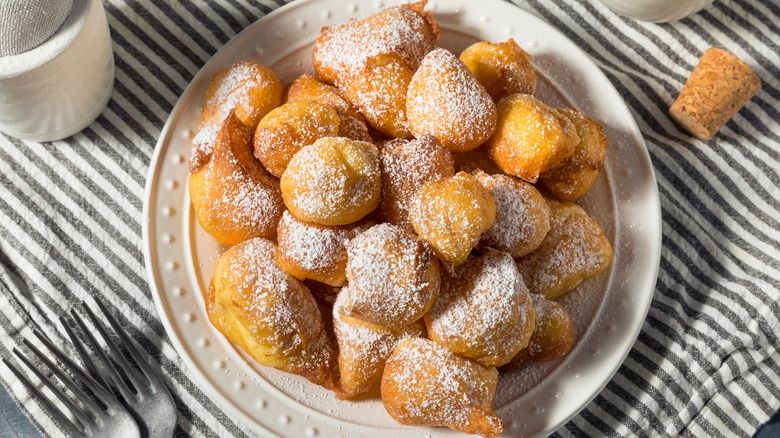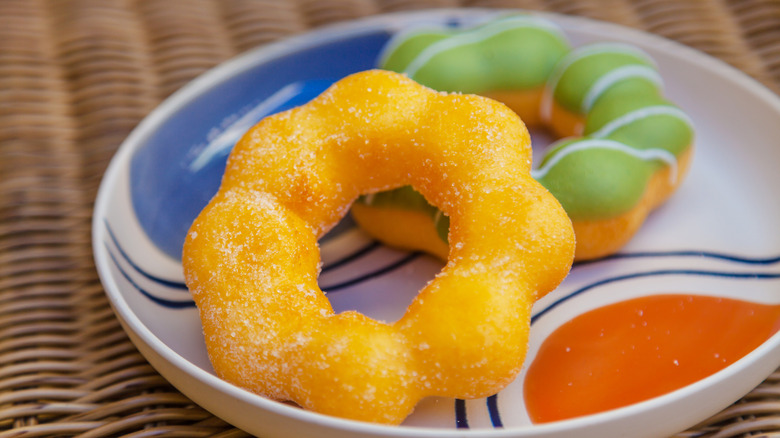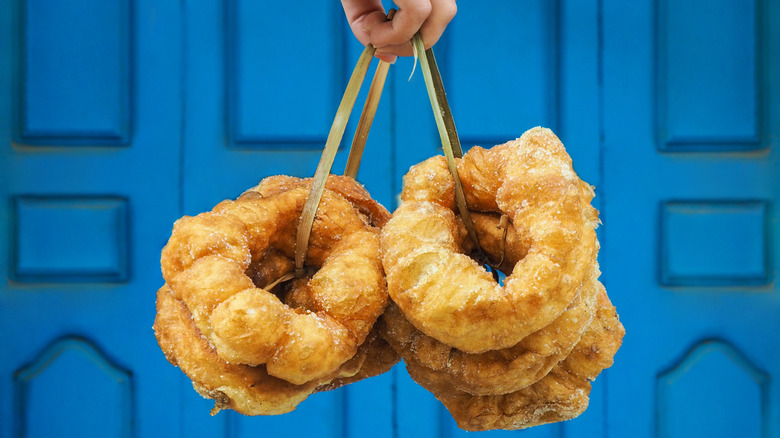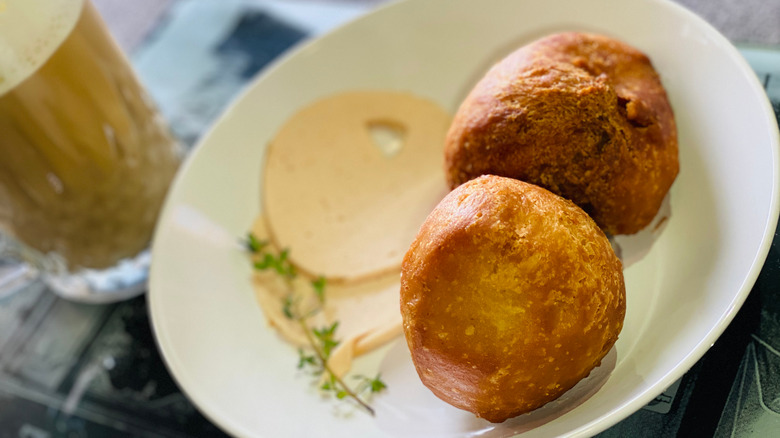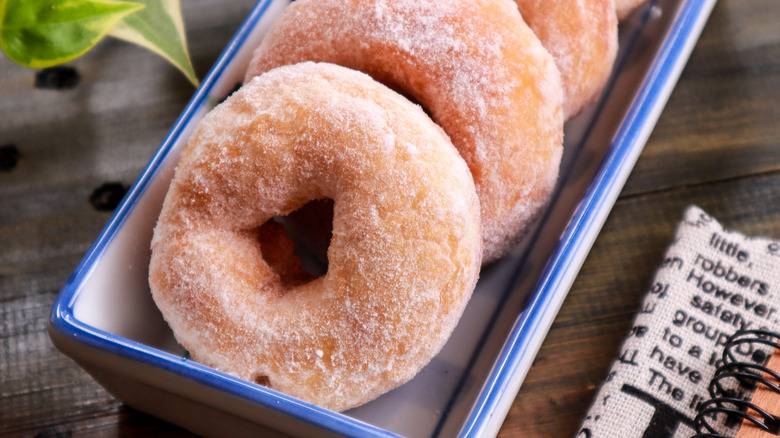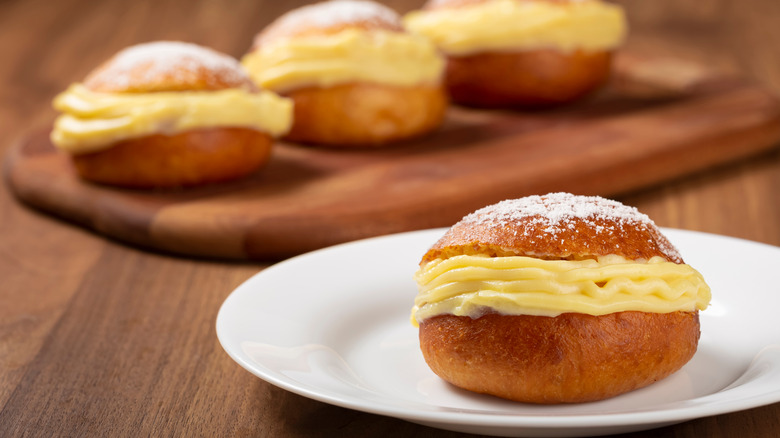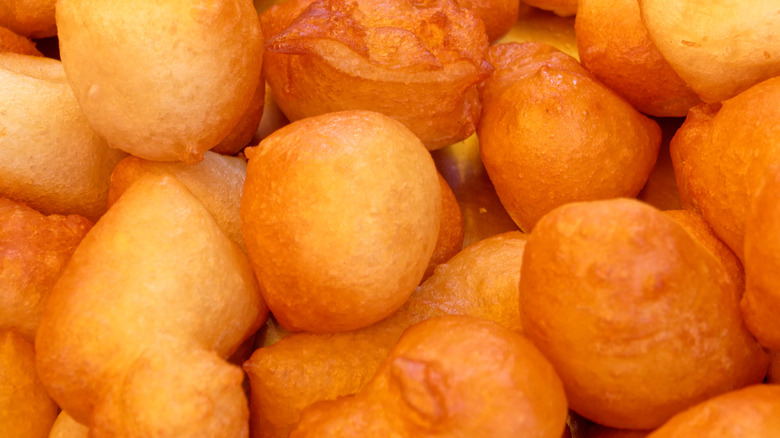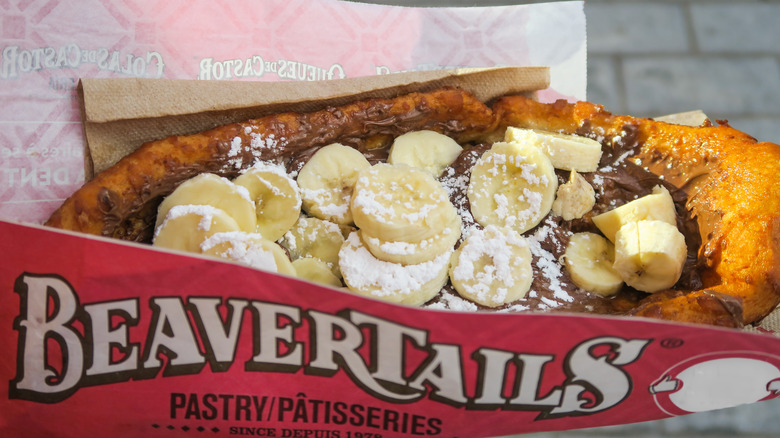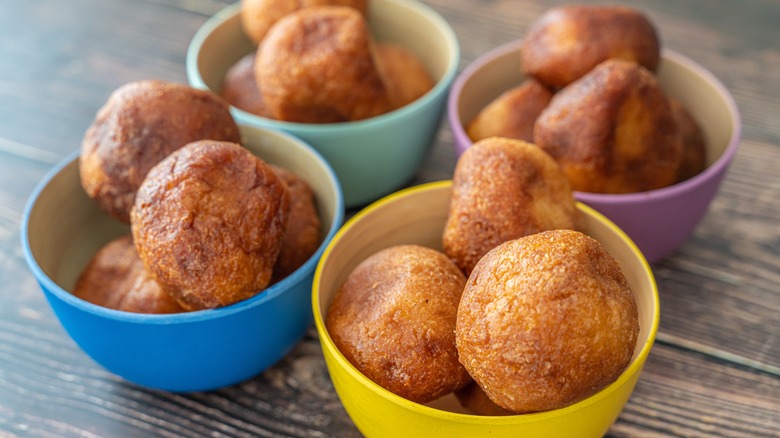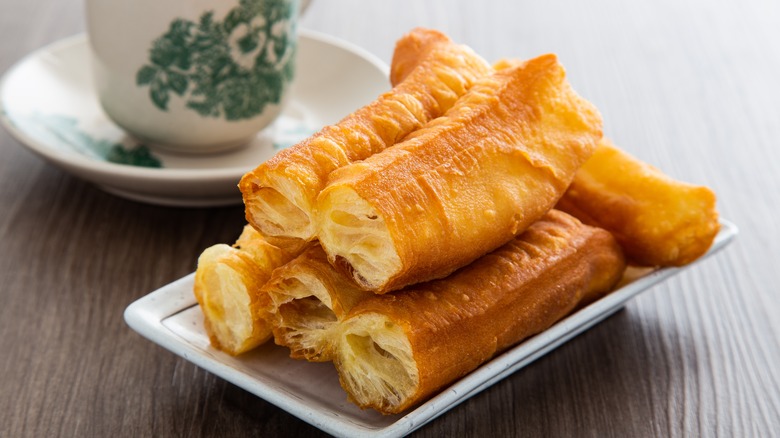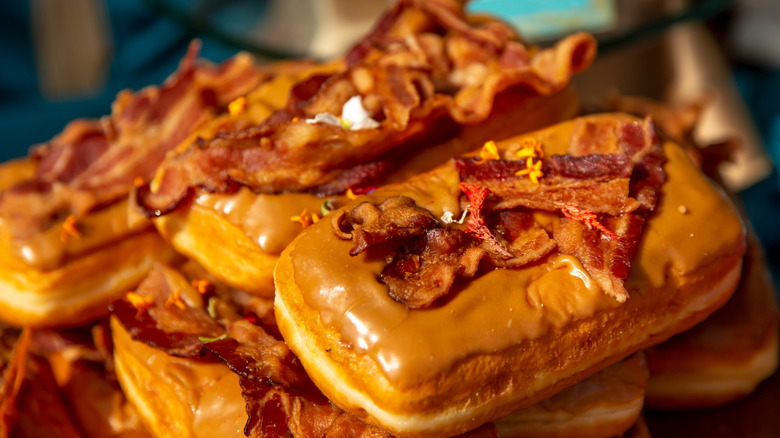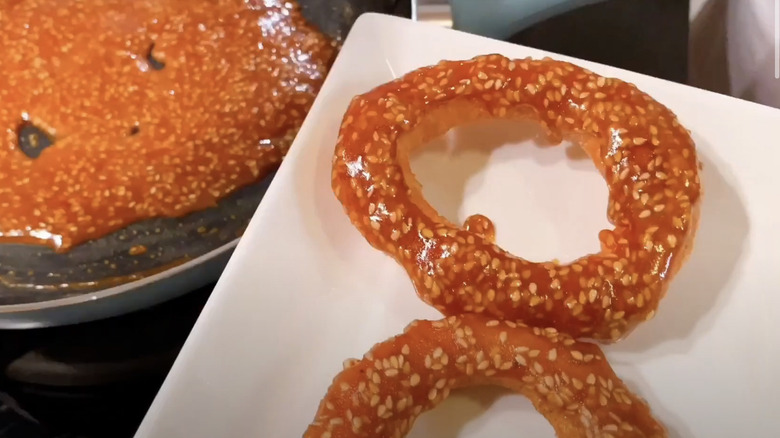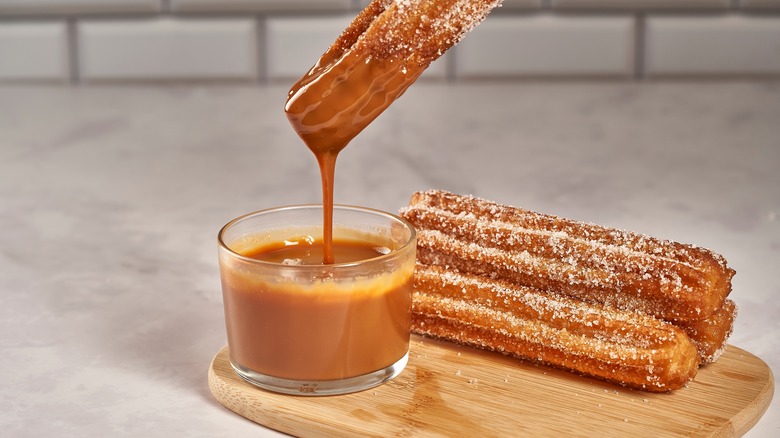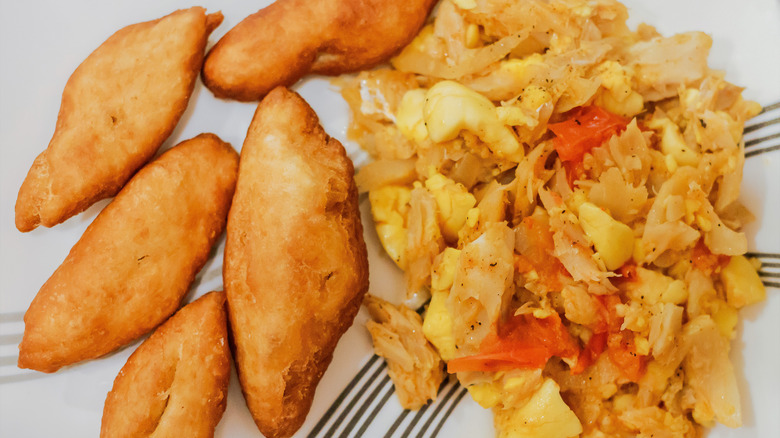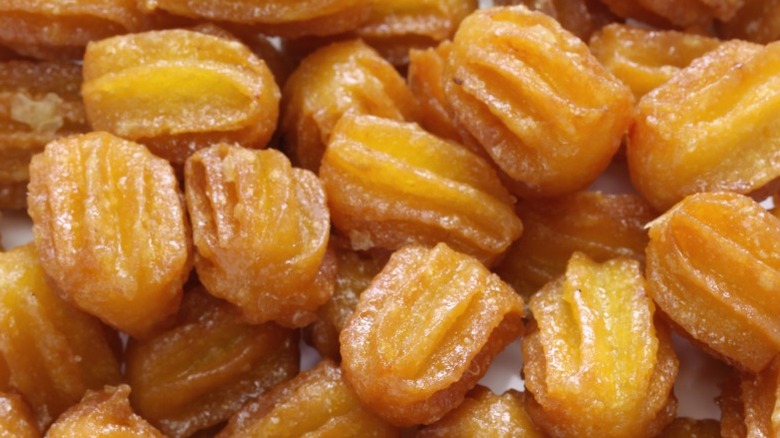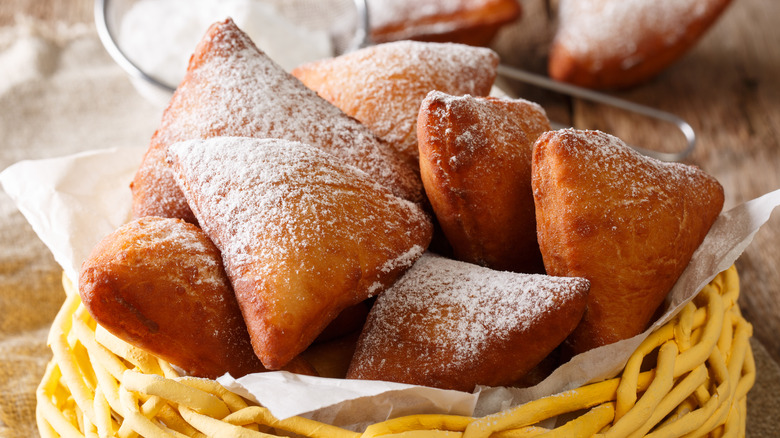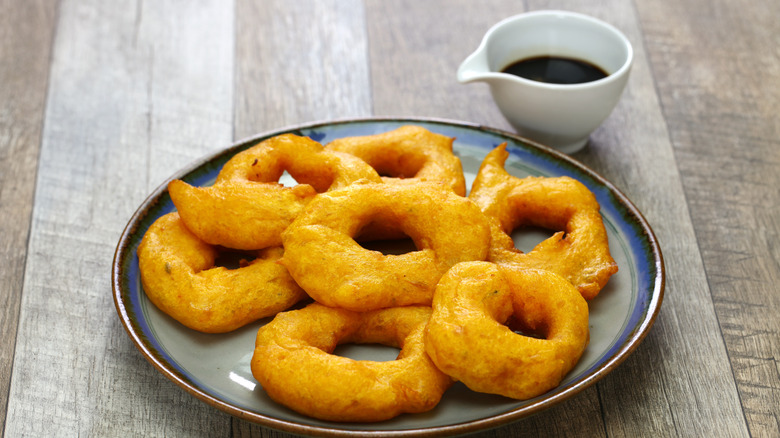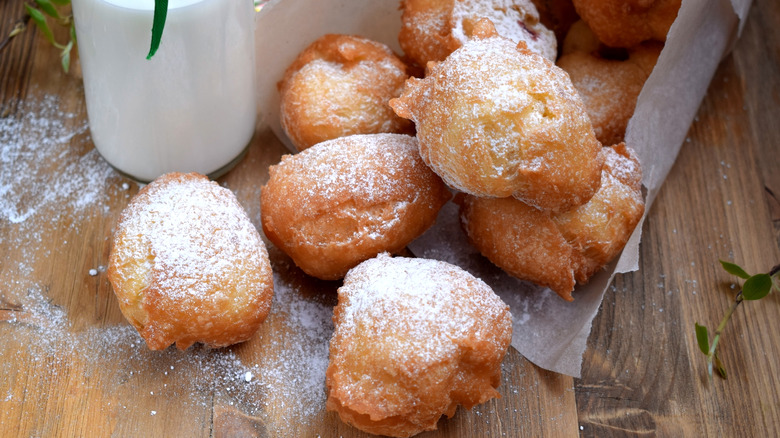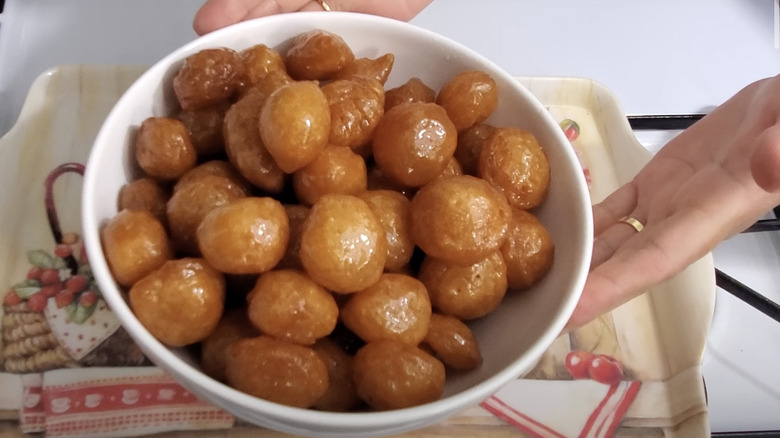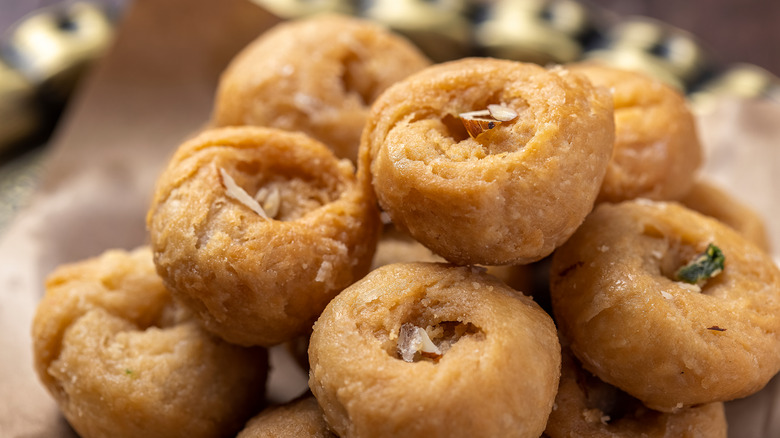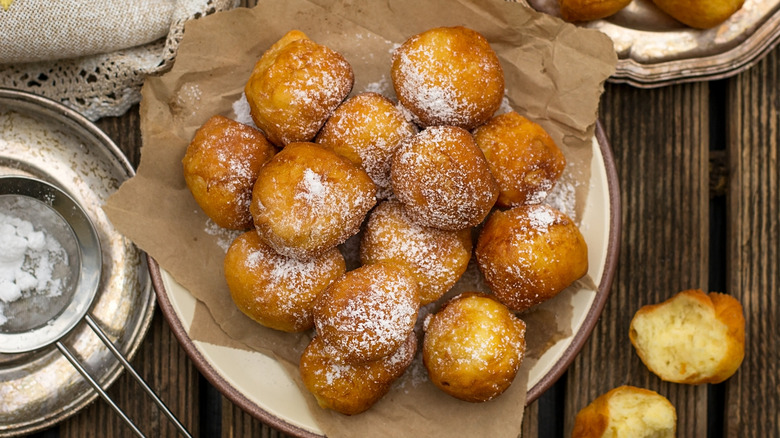21 Ways Donuts Are Enjoyed Around The World
American-style donuts are eaten all across the world, and it's not unusual to find American donut chains selling them wherever you go. As just one example, Dunkin' runs over 11,300 restaurants in 36 countries around the globe. Small, sweet, and a great accompaniment for a cup of coffee, donuts are one of the world's favorite indulgences — a growing appetite for comfort foods means their popularity is only going to keep increasing.
Donuts were originally imported from places outside the United States. Their origins can be traced to Dutch immigrants in the early days of New York. In the 17th century, when New York was still known as New Amsterdam, a popular treat there was known as olykoek, meaning oil cake because of how it was deep-fried in hot oil. By the 19th century, these had become known as donuts and were being made in their classic ring shapes. The rest, as they say, is history.
The idea of frying bread and cakes, however, isn't unique to either New York or the Dutch. Cultures worldwide have their own distinctive variations on the theme of deep-fried dough. Some are sweet, and some are savory, but all are important parts of their local food culture. Here are a few of the most interesting ones.
1. Zeppole: Italy
Italy is widely known for its indulgent desserts, which include many of the finest and most popular selections that Europe has to offer. One among them is known as zeppole. These little balls of fried dough are a bit like the donut holes often seen in the U.S. They are usually served lightly dusted with powdered sugar, but they can also be made slightly more elaborate — being filled with custard, cream, or sweet ricotta cheese. Zeppole are traditionally served in Italy on March 19th for the feast of San Giuseppe, which also doubles as Father's Day. For this occasion, chefs prepare a specific recipe, zeppole di San Giuseppe, in which the puffy fried cakes are topped with cream and black cherry. This festival is most popularly observed in Sicily, where San Giuseppe is the patron saint.
2. Mochi donuts: Japan
Eaten throughout Japan, these donuts have a distinctive string-of-beads look to them and are usually topped with a variety of colorful glazes. They are a relatively recent culinary invention — they were actually invented in Hawaii during the 1990s but were perfected in Japan in the 2000s. They are usually associated with the restaurant chain Mister Donut, often called Misudo, a formerly American restaurant chain that remains popular in Japan. These distinctly Pacific donuts are made with a mixture of taro and mochiko, the latter being the starchy rice flour used to make traditional Japanese mochi. They are lighter and chewier than American donuts and are very popular in Japan.
3. Sfenj: Maghreb
Sfenj is enjoyed all across the Maghreb, the stretch of Northern Africa sandwiched between the Sahara and the Mediterranean Sea, which encompasses countries from Morocco to Egypt. They're often enjoyed with another staple of Maghrebi culture: mint tea. Street vendors in Moroccan markets will make these fresh while you wait, serving them in bunches tied with ribbons or strips of palm leaves. They can be served dusted with sugar or simply eaten plain, and they're popular at breakfast time.
They also hold some cultural significance. Among Moroccan Jews, they're a favorite treat during Hannukah. In Algeria, where they're usually made with semolina flour, there's a tradition to prepare sfenj whenever a baby cuts their first tooth.
4. Magwinya: Southern Africa
The name magwinya is a Tswana word that translates to fat cakes. Popular with children in Botswana and South Africa, these are a favorite comfort food, giving many people nostalgic memories of family kitchens and street vendor stalls. Properly cooked, they're puffy with a crispy exterior and are slightly sweet thanks to the sugar added to feed the yeast they're made with. In South Africa, they're sometimes enjoyed with sliced polony sausage, while they are popularly served with french fries in Botswana. Magwinya is often made or bought fresh for breakfast, but they're a much-loved snack at any time of day.
5. Spudnuts: USA
When it comes to everyday cooking, most people do not think of potatoes as a main ingredient in sweet foods. However, potato donuts, also known as spudnuts, are an American classic. The starch from the potatoes gives these donuts a crisp exterior while their insides are soft and fluffy. Spudnuts can be made much like regular donuts, either filled with jelly or made into rings and glazed.
The exact origins of the potato donut are lost to time, but they likely came about because of what baking yeasts were available. Older recipes call for live yeast mixtures like sourdough, and one which became popular was made from fermented potatoes. It's not a giant step from there to start adding the mashed potato mixture directly into the donut batter itself. Needless to say, potato donuts are a classic home recipe, especially in places where potatoes are abundant, like Idaho.
6. Sonhos: Brazil
The name sonhos translates to dreams, which is accurate since these soft, spongy donuts are certainly dreamy. They can be found in practically any bakery in Brazil, where they are made plain and sliced in two before being filled with sweet custard cream and dusted with powdered sugar. Readily available and with a lighter texture than American-style donuts, they're a popular breakfast treat — though they are often enjoyed for brunch or as an afternoon snack. Like other donuts, sonhos are often eaten together with coffee, particularly because Brazil is well known for some of the best coffee in the world. Adopted into Brazillian cuisine, sonhos are also considered a version of the German donuts known as berliners.
7. Loukoumades: Greece
Greek cuisine is full of unique and distinctive dishes like loukoumades, which are popular sweet treats. Loukoumades are a kind of small donut, deep-fried as small balls which are dipped in syrup or honey before serving. They're usually dusted with a little cinnamon and sometimes also sesame seeds for extra flavor. These sweets are also known as lokma, and are often made by street vendors and distributed to the poor and neighbors during festivals. During Hannukah, loukoumades are enjoyed by Greek Jews, who sometimes call them zvingous. No matter how or where you enjoy these tasty treats, there is no one right way to indulge.
8. Beaver Tails: Canada
When in Canada, you will probably encounter various delicious donuts. Known as beaver tails, this donut is made of flat pieces of deep-fried dough stretched into the shape of an actual beaver's tail and comes with a variety of toppings. Traditionally, they're sprinkled with cinnamon and sugar, but other sweet and savory toppings are also popular. You may find them covered with hazelnut chocolate spread or maple cream.
There are also ham and cheese tails, which are a specialty of Mont Tremblant, while Vancouver's local version is called salmon tails, served with cream cheese and capers. For an extra filling option, beaver tails are sometimes even topped with poutine to make a doubly Canadian dish. Their invention is usually attributed to a company by the same name, but they're likely much older. The original beaver tails were probably a type of bread cooked over an open fire.
9. Puff puff: West Africa
A popular snack and street food in Nigeria is called puff puffs. Small, round, and slightly chewier than American donuts, they're eaten across West Africa. In different countries, they go by other names and have slightly different cooking methods. However, they are all variations of the same theme. These tasty little snacks are simple to make, and most streetside shops in West Africa will sell them. As the name implies, these snacks are soft and spongy. They are an anytime snack, though if you find yourself invited to a Nigerian party, you may just be offered some. Depending on what you most enjoy, puff puffs can be eaten sweet or savory, alone or as a side dish, or with a dusting of powdered sugar or a dash of pepper sauce. There are even some variations to try, like plantain puff puffs or spicy puff puffs.
10. Youtiao: China
Youtiao is a favorite breakfast food in China. Essentially fried breadsticks, they're usually savory food. Puffy with a crispy exterior, it's not uncommon for people to pick up a couple from a street vendor to take home and eat for breakfast. Alternatively, if they're made at home, the usual way is to prepare the dough at night and leave it to rise until the morning. Youtiao can be dipped in sweet soy milk for a light breakfast, or for a more substantial meal, they can be served with chicken congee. Eaten across China, they sometimes go by different names too. In Cantonese, these long donuts are known as yàuhjagwái, which means oil-fried ghosts.
11. Maple bars: USA
Not all American donuts are circular. Maple bars are soft rectangular donuts covered with a mouthwatering sweet maple glaze. A regional specialty, these are ubiquitous all along the West Coast of the U.S., particularly in California, but may be much harder to find in states further to the East. The classic maple bar, as enjoyed in the coffee shops of the Pacific Northwest, is soft, spongy, and unfilled. As always, though, there are some variations, and some maple bars can be found filled with custard or cream. For another interesting version, originally popularized in Portland, they can even sometimes be found topped with crispy bacon as well as their sweet maple glaze.
12. Noum kong: Cambodia
Cambodian cuisine may be unfamiliar to Western palates, but that should not stop people from trying Cambodian donuts as they are absolutely sublime. Known as noum kong, these donuts look a lot like other types of ring donuts, yet they're made with distinctly Southeast Asian ingredients. Noum kong dough is made with glutinous rice flour and coconut milk, sweetened with fragrant palm sugar. That gives them a distinctive sweet flavor and a crispy texture on the outside with a soft and chewy interior. This popular street food in Cambodia is usually topped with a sweet caramel glaze made with palm sugar and sesame seeds.
13. Churros: Spain
Churros are a beloved snack in many Spanish-speaking countries, and while they're a popular part of Latin American cuisine, they're originally from Spain. Crisp on the outside and fluffy on the inside with a distinctive piped shape, churros are a favorite breakfast food in many parts of the world. They're usually dusted with cinnamon sugar and go extremely well served with dulce de leche or a mug of hot chocolate. In Mexico, though, instead of regular hot chocolate, a far better comfort food option is to serve them with champurrado, a spiced chocolate drink sweetened with piloncillo or unrefined cane sugar and thickened with masa harina, a kind of corn flour.
14. Festivals: Jamaica
Jamaican cuisine is full of hot spices, light aromas, and deep wholesome flavors, which go very nicely with festivals. Not to be confused with a celebration or event, festivals are deep-fried bread dumplings made from yellow cornmeal and sweetened with a little brown sugar. They have a thick, crunchy exterior and a more fluffy, crumbly texture than other types of donuts.
Festivals are popularly served as a side dish with Jamaican foods like saltfish, goat curry, or jerk chicken. Alternatively, they make an excellent snack all on their own. Jamaican cuisine also includes a few similar dumplings, like johnny cakes. Some Jamaican dumplings are also stuffed with savory fillings like mutton curry or spicy chicken.
15. Bamieh: Iran
Persian sweets are often made with indulgent syrups full of sweet fragrances, and bamieh is no exception. Enjoyed across Iran, these donuts are made in much the same way as churros but are usually much shorter. They're traditionally served dipped in syrup flavored with aromatic saffron and rosewater, two characteristically Persian flavors. Similar sweets are enjoyed across the Middle East with a few local variations. They're called tulumba in Turkish and balah el sham in Arabic. In some places, the syrup is flavored with vanilla, while in others, larger versions are sliced open and stuffed with whipped cream and chopped nuts. These tasty treats are particularly popular during the Muslim holy month of Ramadan, when they're often served as part of Iftar, the post-sunset evening meal.
16. Mandazi: East Africa
Mandazis are triangular donuts enjoyed across East Africa in countries like Kenya, Uganda, and Tanzania. They're made with a few flavorsome extra ingredients, like cardamom, coconut, and nutmeg. This gives them a flavor distinct from other types of African donuts. Mandazi can be served as a snack with tea or as a side dish with a more substantial meal. They go very nicely with sweet flavors like jam, caramel, or honey, but they're also popularly enjoyed with curry. Traditionally made at home with yeast, a faster version can be made just as easily with baking powder or self-raising flour.
17. Picarones: Peru
The Peruvian version of ring donuts is quite distinctive. Called picarones, these flavorsome treats are made with sweet potato and a type of Peruvian squash called macre. The two vegetables are boiled, mashed, and then mixed in with bread dough which is sweetened with chancaca, a sauce made from unrefined sugar — though other types of unrefined dark sugar like molasses or muscovado work just as well. A traditional Peruvian sweet, these are easily found on sale as street food in cities like Lima. The vendors who sell them carefully shape the dough by hand, throwing them into the oil and cooking them until golden brown. They're best enjoyed while still piping hot, drizzled with some chancaca syrup.
18. Beignets: France
Americans will know beignets as a specialty of New Orleans, but they were originally a part of French cuisine. And there are a few differences between how they're made on either side of the Atlantic — the most notable is that in France, there are numerous types of beignets. They are usually made from choux pastry (like eclairs and profiteroles), though there are some yeast dough beignets too. They are also usually small, round, filled, and may be dusted with powdered sugar.
On the other hand, the Louisiana version of beignets is almost always square and tends to have a crispier exterior. These are a favorite snack often paired with coffee. In the city of New Orleans, they can be found in many different bakeries, coffee shops, and grocery stores.
19. Zalabiyeh: Middle East
Quite similar to Greek loukoumades, zalabiyeh are small donuts eaten all around the Middle East, where they go by a few different names from country to country. Light and fluffy, zalabiyeh are traditionally served soaked in syrup with a little cinnamon, though they can just as easily be enjoyed dusted with powdered sugar or drizzled with warm chocolate sauce. The recipe also varies, and they're sometimes made with yogurt instead of water for a richer flavor. Like many Arabic sweets, zalabiyeh are especially popular during Ramadan.
A dish with a similar name is also enjoyed by Palestinians. While most zalabiyeh are small and round, Palestinian zalabiyeh are large and flat. Stuffed with sesame seeds, zalabiyeh are nicest while freshly fried and best served with a kind of pumpkin jam called halaweh.
20. Balushahi: India
Indian sweets are famous for their staggering variety and indulgent richness. Perhaps the most donut-like of them are known as balushahi which appear, at first glance, quite a lot like American glazed doughnuts. Small and ring-shaped, these sweets come from Northern India and have a very different texture from other donuts. For example, these donuts are much crispier and flakier.
Balushahi is also made with ghee, which has a richer, deeper flavor. After being deep-fried, they're traditionally soaked in sugar syrup flavored with cardamom, saffron, and a dash of lemon. Like many other Indian sweets, they're very popular during festivals like Diwali, when it's quite common to see a plate of them at celebrations.
21. Bunwelos: Philippines
The name buñuelo is used in many Spanish-speaking countries, though the outcome isn't always the same. The bunwelos – also spelled bunuelos or binowilos — eaten in the Philippines are small, round, and sometimes filled. The dough is flavored with anise, and they're served sprinkled with sugar or drizzled with hot cane sugar syrup.
There are many versions of this treat around the world. Mexican buñuelos, for instance, are round, flat fritters that are bubbly and airy. Fried till crispy, they're sprinkled with sugar and a little cinnamon. Colombian buñuelos, meanwhile, are cheese fritters — small balls made from corn starch and yucca flour, stuffed with a white cheese quite similar to feta. While undoubtedly different, all buñuelos still share one thing in common: They are all popularly enjoyed around Christmas time. The Filipino version is also eaten during celebrations like birthdays and baptisms.

